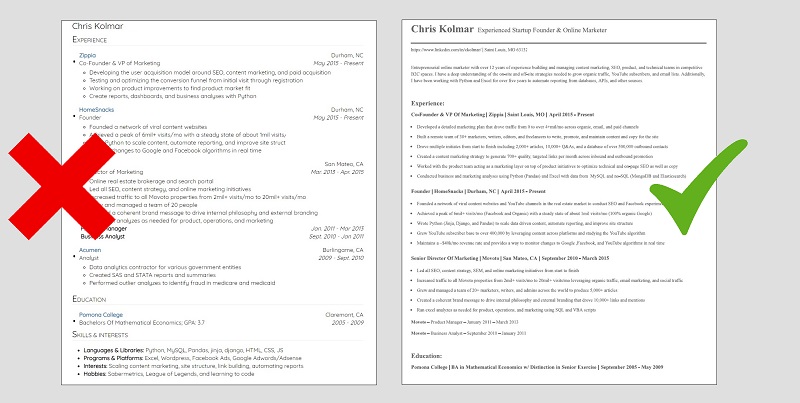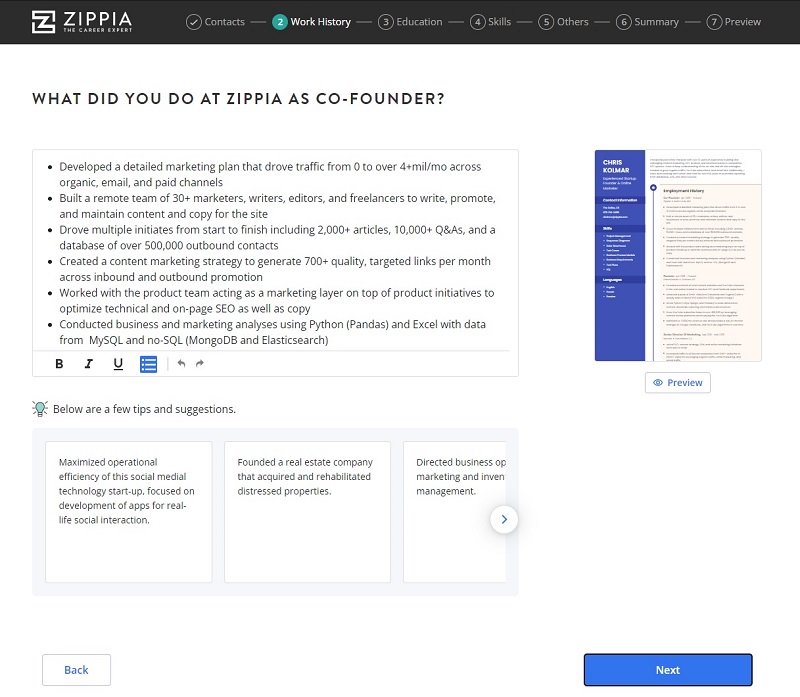- Parts Of A Resume
- How To Write A Resume
- Resume Skills Section
- Resume Objective Section
- Career Objective Section
- Resume Reference Section
- Resume Summary Section
- Resume Summary Example
- Resume Interests Section
- Address On Resume
- Relevant Work Experience
- Anticipated Graduation Date On Resume
- Education Section On Resume
- Contact Information On Resume
- Statement Of Qualifications
- How To List Publications On Resume
- Accomplishments On Resumes
- Awards On Resume
- Dean's List On Resume
- Study Abroad On Resume
- Resume Format
- Resume Templates
- General Resume Examples
- Resume Builder
- Resume Format
- Resume Margins
- Resume Header
- Work Experience On Resume
- Irrelevant Work Experience
- Listing Languages On Resume
- Volunteer Work On Resume
- GPA On Resume
- Resume Title
- Summary Of Qualifications
- Resume Picture
- Python Project On Resume
- Google Docs Resume Template
- Professional Bio On Resume
- Multiple Positions At Same Company
- Relevant Coursework Resume
- Where And How To Put Internships On Your Resume
- Professional Resume Formats
- Resume Types
- What Is a Chronological Resume?
- How the Chronological Resume Format Can Help You
- Update Your Resume Now To Get Your Next Job Faster
- How to Write a Chronological Resume
- When Should I Use a Chronological Resume?
- Chronological Resume Example
- Additional Chronological Resume Sections
- Other Resume Formats
- Sign Up For More Advice and Jobs
When you think of a resume, there’s a good chance you’re thinking of a chronological resume. They are the most popular way to structure a resume today and preferred by many human resources departments, hiring managers, and recruiters.
A chronological resume is one of the most common resume formats because employers (and the applicant tracking systems they often use) prefer the easy-to-scan structure.
The chronological resume lists your work history in order of date, with your most recent work experience listed at the top. It may also include a resume objective or summary prior to listing your work experience.
However, there are a variety of different resume formats, and chronological is only one way to structure a professional resume. For example, if you are an applicant with work history gaps or career changes, you may be better served with a combination resume.
Below, we outline some important tips that you can use to decide if this format is right for you and the job you are seeking.
Want to save time and have your resume ready in 5 minutes? Try our resume builder. It’s fast and easy to use. Plus, you’ll get ready-made content to add with one click. See 10+ resume templates and create your resume here.

One of users, Diana, had this to say:
I was guided on how to make a detailed and professional resume on Zippia. I was able to download it with unlimited access to all features.
What Is a Chronological Resume?
A chronological resume is a resume that lists your professional experiences in the order that you had them, with your most recent jobs listed at the top and your more distant work experience following it. This is technically reverse-chronological order, but the term “chronological resume” is much more commonly used.
The chronological resume is by far the most popular resume format in the modern world because it’s the best option for presenting your experiences and qualifications in a logical and straightforward way.
Previous job experience consistently ranks as the most important factor of your application to recruiters and hiring managers, so it makes sense that these people prefer to see your professional history laid out clearly and in a logical order.
One thing to note is that the reverse-chronological aspect of your resume applies to each section separately. In other words, you wouldn’t place your college experience in between two jobs you held just because that’s when you went to school — you still separate sections based on work experience, education, skills, and any other resume sections you’re using.
How the Chronological Resume Format Can Help You
As one of the most common resume styles used today, the chronological resume provides familiarity and makes it easier for the reader to absorb the information included. This resume format accommodates all types of industries and all levels of experience.
Human resources departments often prefer this formatting because it is what they are most familiar with and it is the easiest to scan. Consider the fact that some HR departments look at hundreds of applicants per day, so you should do your best to make yours stand out from the crowd.
Ideally, your chronological resume will show the progression of your work history and career in a positive light. Because of this, chronological resumes may not work for recent graduates, applicants with little to no work experience, or those with work gaps or career shifts.
You should use a chronological resume:
-
If you have several years of experience in a single career path
-
If you have worked in a single industry
-
If you have minimal or no employment gaps
Additionally, the chronological resume can be easier to compile since its dependency on dates helps you nail down the details of your job history.
Employers and hiring managers may only glance at your resume quickly, scanning just the important details. It’s imperative that you highlight your most recent information and accomplishments first, and ensure they are relevant to the job you’re applying for.
Update Your Resume Now To Get Your Next Job Faster

How to Write a Chronological Resume
You should aim to make your resume include information that relates to the position you are applying for. The most significant difference between a chronological resume and other resume formats is how the experience section is formatted.
List your most recent experience first. Pay attention to the details under each job experience and make sure you pull keywords from the job description for which you are applying. If you insert them naturally into the copy on your resume, it will feel like a perfect fit for your hiring manager or recruiter.
Additionally, you can choose how to best format your professional experience and education section. If you are a student, you may choose to prioritize your education section with relevant accomplishments, awards, and coursework for your potential employer.
To use a chronological resume, your sections should be split in this order:
-
Contact information. This is the most vital information on your resume. Make sure this is highlighted appropriately and displayed prominently. Always double-check the information in this section. If your potential employer can not contact you with the correct details, you may miss out on your job opportunity.
Important note: Applicant tracking systems can’t read information in headers or footers, so make sure that your contact information is not in a header.
-
Summary or objective. Typically resumes will include either a resume summary statement or resume objective. This is a short statement that describes who you are as a professional. It gives your potential employer a quick context of who you are, what your experience looks like, and what you believe your key skills are.
Those with extensive experience in a specific industry should include this in the summary, especially if you are applying for a job in the same industry.
New graduates or those still in school should consider the objective statement instead, which describes your short-term goals.
-
Professional experience. Under your professional experience, you will list all of your work experience in past and present jobs in reverse-chronological order. This means starting with your current or most recent position, and working backward while listing dates.
When writing this section, consider the experiences that are relevant to the next step you’re planning to take in your career.
For example, for a job that is not as relevant, you can provide minimal details to save some space on your resume. When writing your dates for each job, ensure you double-check that they are correct to avoid confusion on the hiring manager’s part if they choose to cross-check the information.
-
Educational history. The education section is where you’ll list your degree, where you went to school, and your GPA if you so choose. Just like professional experience, your education experience should be listed in reverse-chronological order, listing your most recent educational achievements and working backward.
Note that if you have completed a post-secondary degree in college, you do not need to list your high school information. However, if you did not complete a post-secondary degree, you should consider including your background from high school, along with your GPA, and any other relevant information.
This is also the place where you can also share any awards or certifications you have received.
-
Skills and abilities. The purpose if your key skills section is to highlight your attributes and skills. Don’t forget to include both technical (hard) skills and interpersonal (soft) skills here. The most important thing to pay attention to is to make sure these skills are relevant to the job you’re applying for.
Often, job descriptions will call out the exact skills they expect to see, so take a look at the posting to ensure you’re sprinkling the right skills throughout this section.
What are some resume tips?
Darrell W. Gurney
The “CareerGuy”
Think of a resume not as a bio, detailing your whole career, or an essay paper, which needs to have complete and perfect sentences. Think of your resume as a marketing piece, the objective of which is to tease enough interest (think “movie trailer“) and evoke enough curiosity that someone wants to follow up and have a conversation. Your resume should invite conversation and interaction from people who want to know more.
Often, little words can be taken out of sentences to make them more punchy and “marketing copy”-ish. And, for sure, a resume must be Accomplishments-driven in today’s behavioural interviewing world. Think of short stories of “Actions” you took, followed by specific and measurable “Results” that came about from those actions. Demonstrate your value to get a conversation going.
The rest is interview performance!
When Should I Use a Chronological Resume?
Although anyone can use a chronological resume, it’s most effectively used by applicants who have a solid work history in a single field. The format allows you to showcase work history front and center, as the most important piece of your resume. This shows the employer that you have the specific sets of skills and abilities they may be looking for in a job.
For those who are just beginning their career journey, the chronological resume can be tricky. You likely have an abundance of skills and experience that falls outside of actual paid work history that you can list. This includes work such as volunteering, school clubs, or extracurricular activities.
When you use a chronological resume with this type of experience, it could work against you. It will be blatantly obvious to the hiring manager that you lack paid work experience.
If you are in the process of making a career leap, the chronological resume may also not work the way you want it to. If you’re applying for a job that requires a specific set of skills, it’s not ideal to go in with a resume that highlights your experience in a different industry.
You would be better served to use a resume like a combination resume, which lists both skills and work history, with an emphasis on skills (this is a functional resume, and we’ll talk more about it later).
Additionally, if you have gaps in your work history or you have changed jobs frequently, it’s probably not ideal to use a chronological resume either. The chronological format highlights gaps and shifts front and center. Although job-hopping is no longer a concern in the workspace, too many job changes could signal a red flag for your potential employer.
Then again, there’s one more thing you can do.
Make a new resume and get more interviews.
Plus, a great resume will give you an advantage over other candidates. You can write it in our resume builder here. Here’s what it may look like:
Chronological Resume Example
The chronological resume is a fairly straightforward and simple template. To some extent, all resumes will look a little different, but the components and relevant information should remain the same across the board. Below is an example of what a chronological resume may look like in practice:
Lila Craft
18 Cross Road, Denver, Colorado 80014| [email protected] | 134-234-2123
Marketing manager seeks management position with top technology company that will allow her to utilize her digital marketing and content marketing skills, while coordinating marketing efforts to improve sales and drive sales qualified leads.
Professional Experience
Salesforce, Inc — Marketing Manager
April 2018-Present
Manage and maintain Marketo for micro-Salesforce events, including drip campaign set-up, database management, and email creation across events.
Provided social copy for all relevant events used by Twitter, Facebook, Instagram, and LinkedIn
Monitored the customer service email box for any pressing questions from attendees prior to the event
Coordinated all event logistics for both external and internal attendees
Accenture, Inc — Marketing Assistance
November 2014-April 2018
Assisted with the development of their new event website including photo selection, web copy, design layout, and logistics management
Developed SOPs for Pardot which was shared across the full marketing team
Education
Colorado State University | May 2014
Bachelor of Arts, English
Minor, MarketingSkills
Marketo
Pardot
Constant Contact
Salesforce
Microsoft Office suite
Google suite
Adobe Illustrator
Adobe Photoshop
Additional Chronological Resume Sections
We kept things pretty basic because the sections above are all you really need to make your chronological resume work. But if you’ve got other experiences you feel would benefit you to share with the hiring manager or recruiter, by all means, include them.
Optional resume sections include:
-
Achievements, honors, and/or awards. While a section dedicated to professional accomplishments can work, we recommend weaving your achievements into your resume’s work experience section and expounding on one or two accomplishments in your cover letter.
A section dedicated to honors and/or awards works especially well for someone working in academia, for non-profit organizations, or for scientific research. Also, recent graduates (including recent high school graduates) might find a section for awards useful for demonstrating their skill sets.
-
Publications. This section is basically mandatory for academic and research-type professionals. But a subject matter expert in any field who has publications under their belt should certainly highlight those for hiring managers to see.
-
Volunteering. A volunteer experience section works great for those without much professional experience or folks looking to cover up awkward gaps in their employment history. However, in most cases, it’s best to include your volunteering experience within your professional history section, especially if it’s for the purpose of concealing employment gaps.
-
Certifications. Certifications can also fit into your education section, but if you work in a field that’s heavy on licensures and certifications, it dedicating a section to such can help draw the hiring manager’s eye straight to the most important aspects of your background.
-
Hobbies, interest, and/or extracurriculars. This optional section is more for recent high school or college graduates who lack formal experience, but it can also be valuable for folks looking to make a radical career change.
Regardless of your reason for using this section, make sure that you tie your outside-of-work activities to the job description. For example, being a well-ranked chess player could speak to your problem-solving abilities.
Other Resume Formats
While the chronological resume is the undisputed champion of the resume formatting world, it’s helpful to know about the other options. Plus, there are only two other options, so we felt it worth the time to briefly describe what they are, their advantages, and when to consider using them:
-
Functional resume. The functional resume flips the chronological format on its head. Instead of kicking off with professional experience, a functional resume moves straight from the summary/objective to your most impressive skills.
But instead of giving only a list of skills without detail, a functional resume aims to provide fewer skills (4-6) but with a greater level of detail given for each (3-4 lines).
Then, you follow this up with your education or relevant experience section. For relevant experience, you should still list your jobs in reverse-chronological order, but you don’t have to (or even include dates). The whole idea of a functional resume is that it hides your lack of recent, relevant experience and brushes over long gaps in your employment history.
It also emphasizes skills over experience, which makes it a great option for those looking to change careers in a significant way and want to draw attention to their transferable skills.
While this format is good for certain folks looking to show off a diverse skill set, recruiters and hiring managers are wise to the fact that functional resumes purposefully conceal your work history. That raises a red flag for them. Additionally, applicant tracking systems may have a harder time reading and understanding this information, as these programs score candidates primarily based on their years of experience.
-
Combination resume. As you might imagine, a combination resume attempts to combine the best of both the chronological and functional resume formats. You still lead with a detailed skills section (albeit slightly briefer than a functional resume) and then move into an equally impressive experience section in reverse-chronological order.
For a combination resume, you should list the years to indicate you haven’t had any gaps in your employment history (unless you do have gaps, in which case you can opt to omit years — but again, applicant tracking systems don’t like that).
A combination resume works best for those with tons of professional experience who are looking to land an upper-level executive role. It also works for those with a diverse portfolio or a rich and varied professional history. They’re hard to format, but can be super compelling for hiring managers looking for a candidate with a suitably deep background.
- Parts Of A Resume
- How To Write A Resume
- Resume Skills Section
- Resume Objective Section
- Career Objective Section
- Resume Reference Section
- Resume Summary Section
- Resume Summary Example
- Resume Interests Section
- Address On Resume
- Relevant Work Experience
- Anticipated Graduation Date On Resume
- Education Section On Resume
- Contact Information On Resume
- Statement Of Qualifications
- How To List Publications On Resume
- Accomplishments On Resumes
- Awards On Resume
- Dean's List On Resume
- Study Abroad On Resume
- Resume Format
- Resume Templates
- General Resume Examples
- Resume Builder
- Resume Format
- Resume Margins
- Resume Header
- Work Experience On Resume
- Irrelevant Work Experience
- Listing Languages On Resume
- Volunteer Work On Resume
- GPA On Resume
- Resume Title
- Summary Of Qualifications
- Resume Picture
- Python Project On Resume
- Google Docs Resume Template
- Professional Bio On Resume
- Multiple Positions At Same Company
- Relevant Coursework Resume
- Where And How To Put Internships On Your Resume
- Professional Resume Formats
- Resume Types





